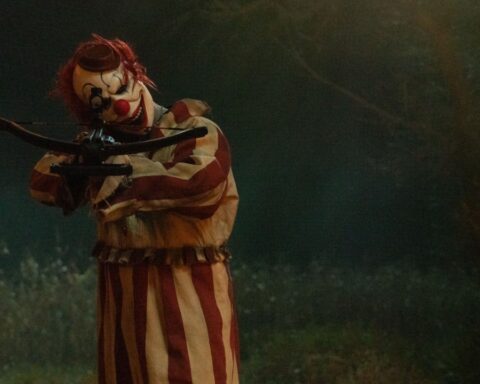Shark movies have long held a special place in the hearts of cinema-goers, serving as both a source of thrill and an exercise in our primal fears. The allure of the shark attack is something that stirs a spectrum of emotions, from sheer terror to morbid curiosity. This genre has an uncanny ability to tap into deep-seated anxieties, presenting sharks as daunting antagonists who lurk in the depths, waiting to strike. Yet, despite—or perhaps because of—this fearsome portrayal, shark films continue to entice audiences worldwide.
Culturally, these movies have done more than just pedal fear; they’ve also become a form of escapism. In a shark film, the ocean becomes an arena where humankind faces nature’s most efficient predators, and this dynamic allows viewers to project and process their anxieties in a controlled space. There’s a peculiar comfort in knowing that, while the dangers on screen are palpable, they are safely contained within the cinematic experience.





The fascination with shark movies can be traced back to the primal instinct for survival. Seeing a shark on screen immediately triggers an adrenaline rush, a flight-or-fight response that, in the context of the cinema, manifests as pure excitement. The blend of thrill and terror keeps the viewer on edge, making each film a roller coaster ride of emotions. Moreover, the shark itself has become a cultural icon, from the menacing force in Jaws to the near-unstoppable creature in The Meg. This iconic status cements the shark’s place in the annals of pop culture, making each new film a highly anticipated event.
In essence, shark movies offer a unique combination of dread and fascination, making them an irreplaceable staple of the film industry. Whether you’re an adrenaline junkie, a cinephile seeking deeper themes, or just someone looking to be entertained, shark movies provide an engaging blend of thrills and intellectual intrigue.

1. Jaws (1975): The Granddaddy of Them All
In 1975, Steven Spielberg introduced the world to a cinematic experience that would forever change how audiences view the ocean and its inhabitants. “Jaws” is more than just a film; it is a cultural phenomenon that birthed an entire genre dedicated to shark attacks and oceanic terror. The storyline centers around a massive great white shark that terrorizes the fictional Amity Island, drawing blood, screams, and an unrelenting sense of fear.
The plot pivots around Police Chief Martin Brody, played by Roy Scheider, marine biologist Matt Hooper (Richard Dreyfuss), and grizzled shark hunter Quint (Robert Shaw), as they band together to end the shark’s reign of terror. Iconic moments, like the chilling opening scene of a late-night swim gone horribly wrong or the laughter-turned-screams of children as they spot the dorsal fin, are forever etched in the annals of cinema history.
One of the most fascinating aspects of “Jaws” lies in its production challenges. Mechanical issues with the shark, affectionately named “Bruce” after Spielberg’s lawyer, resulted in the creature appearing less frequently on screen than initially planned. Far from a setback, this limitation forced the filmmakers to rely on suspense, music, and deft camera work to build tension, ultimately making the unseen terror all the more frightening.
Spielberg’s film elevated the fear of sharks from a niche concern to a worldwide phobia, leading to a surge in public interest and scientific study of these majestic predators. The combination of John Williams’ haunting score and Spielberg’s masterful direction keep the fear alive, even in seemingly safe places. Some might argue that “Jaws” is responsible for why even a swimming pool can provoke a second thought about what’s lurking beneath the surface.
In essence, “Jaws” did more than scare people out of the water; it revolutionized cinema by introducing the first true blockbuster and demonstrating the terrifying power of what we can barely see but fear absolutely.

2. Deep Blue Sea (1999): When Sharks Get Smart
“Deep Blue Sea” (1999) stands as a thrilling yet somewhat absurd piece of cinema that brilliantly merges horror with action. Directed by Renny Harlin, the film thrusts viewers into an underwater research facility where scientists, in an audacious bid to cure Alzheimer’s disease, genetically engineer sharks to have enhanced intelligence. This scientific endeavor, however, spirals into chaos when the super-smart sharks begin to outmaneuver their creators, leading to a cascade of harrowing shark attacks and high-octane sequences.
One of the most notable aspects of “Deep Blue Sea” is its array of over-the-top performances. Samuel L. Jackson’s stirring monologue before his unexpected demise is a standout, while Saffron Burrows and Thomas Jane contribute solid portrayals of researchers caught in a deadly game of survival. LL Cool J delivers a unique blend of comedic relief and heroism, particularly memorable is his parrot-stealing scenes that inject humor amid the escalating tension. His culinary wisdom and unyielding spirit make him an unlikely but beloved hero.
The film is admired for its innovative shark attack scenes that combine practical effects with early CGI to deliver moments of genuine terror and abrupt surprises. The underwater setting, compounded by the sharks’ enhanced intelligence, creates an environment filled with suspense and unpredictability. Additionally, the juxtaposition of horror and absurdity is masterfully handled, allowing the film to straddle the line between serious thriller and campy fun.
On a more intellectual note, “Deep Blue Sea” poses significant ethical questions regarding genetic engineering. The film pushes audiences to consider the ramifications of manipulating nature, as the unintended consequences depicted reflect genuine anxieties surrounding scientific overreach. It underscores the ethical ambiguities inherent in using advanced technologies to solve human problems, stimulating thought on the boundaries of scientific progress and the potential dangers when human ambition exceeds caution.

The Shallows (2016): Survival of the Savvy
“The Shallows” (2016) offers a gripping survival thriller that contrasts stunning cinematography with heart-pounding suspense. This film situates us in the perilous position of Nancy Adams, portrayed by Blake Lively, who finds herself stranded just a mere 200 yards from shore. Her adversary? A merciless great white shark. The minimalist approach taken by the director, Jaume Collet-Serra, focuses almost exclusively on Nancy’s solitary struggle, making the tension palpable and personal.
The brilliance of “The Shallows” lies in its execution of a simple yet effective narrative. The film’s premise hinges on Nancy’s ingenuity and resourcefulness as she employs a series of clever survival tactics to outwit the shark. Her struggle is not just physical but mental, highlighting her resilience amid terrifying odds. The scenario encapsulates the raw battle between human persistence and nature’s ferocity, making every moment a nail-biter.
What sets the film apart is its immaculate cinematography, capturing the ocean’s serene beauty that starkly contrasts with the lurking danger. The director trades conventional horror tropes for a more realistic suspense, keeping the audience engaged through genuine tension rather than sheer shock value. Moreover, the realistic depiction of the shark and careful pacing ensures that the film remains credible throughout.
Amidst the intense drama, there’s a touch of humor for the discerning eye. While the film makes you marvel at Nancy’s bravery, it also offers a subtle reminder about the perils of solo surfing. As Nancy battles the great white shark with remarkable finesse, one may find themselves reconsidering their plans for a lone surfing adventure.
In revitalizing the shark-attack genre, “The Shallows” stands out with its one-on-one battle narrative, lifting it beyond a mere creature feature into a visually and emotionally compelling film. It’s a fresh take that seamlessly blends beauty and terror, capturing the essence of survival against nature’s most fearsome predator.

4. Sharknado (2013): The Absurdity That Took the World by Storm
“Sharknado” is not your typical shark movie; it’s a spectacularly ridiculous adventure where tornadoes hurl hundreds of man-eating sharks onto unsuspecting Los Angeles residents. The film plunges viewers into a whirlwind of inconceivable plots, flagrantly defying the laws of nature and physics, with sharks raining down on the city, causing chaos and mayhem.
Despite—or perhaps because of—its low-budget special effects and kitschy premise, “Sharknado” managed to charm a global audience. Its unapologetically campy humor, coupled with self-awareness, embraced its status as a quintessential guilty pleasure. The CGI sharks may lack realism, but the film’s earnest absurdity is what makes it unforgettable. You’re not supposed to watch “Sharknado” for deep philosophical insights; you’re meant to revel in its unabashed silliness and marvel at how far it goes to entertain.
A significant part of the film’s success can be attributed to social media. As soon as it premiered on SyFy, viewers took to Twitter and Facebook, propelling the movie into a viral sensation. The real-time commentary and memes turned “Sharknado” into a cultural phenomenon overnight. It became one of those rare cinematic moments where the community-driven response far eclipsed the film’s original expectations.
As if one “Sharknado” wasn’t enough, the movie spawned a remarkably long line of sequels, each escalating the zaniness. “Sharknado 2: The Second One,” “Sharknado 3: Oh Hell No!,” and several more followed, each layering on more preposterous plots and increasingly bizarre cameos. Our heroes frequently find themselves in greater jeopardies—from outer space to time travel—proving that when it comes to shark-themed films, absurdity knows no bounds.
Ultimately, “Sharknado” stands as a unique artifact in the cinema, illustrating how embracing the absurd can create an endearing and enduring film experience. It’s a joyful reminder that movies don’t always need million-dollar effects to make a splash; sometimes, all you need is a tornado full of sharks.

5. Open Water (2003): A Realistic Thriller that Hits Too Close to Home
“Open Water” (2003) is a tour de force in the realm of shark movies, deftly combining the sharp edge of realism with gripping suspense. Based on a harrowing true story, the film chronicles the agonizing ordeal of a couple left stranded in shark-infested waters after a diving expedition gone awry. The stark, unembellished storytelling foregoes the grandeur often associated with cinema, opting instead for a documentary-style approach that underscores its unsettling narrative.
The film’s power lies in its brutal simplicity and reliance on natural tension. The ocean, vast and indifferent, becomes a silent antagonist, amplifying the couple’s psychological descent into fear and despair. Unlike its more fantastical counterparts, “Open Water” doesn’t rely on special effects or an oversized, CGI-crafted predator to convey its terror. Instead, it leverages the primal fear of isolation and helplessness, crafting a tense atmosphere where every ripple in the water could spell doom.
Furthermore, the film’s minimalist production style drives home the authenticity of the couple’s plight. By eschewing elaborate set pieces and overwhelming musical scores, it grounds the viewer in a reality that’s frighteningly plausible. The shark attacks, when they occur, are starkly believable, rooted in the predatory nature of these oceanic creatures rather than exaggerated cinematic mythos.
This stark realism sets “Open Water” apart from other shark movies that delve into the realm of the implausible. As viewers are drawn into the couple’s nightmare, the film serves as a haunting reminder of the ocean’s unpredictability, capable of turning any beach vacation into a seemingly less enticing prospect. For those who prefer their shark cinema with a side of psychological depth rather than fantasy, “Open Water” offers an unnervingly realistic glimpse into the terror of being truly at the mercy of nature.
While our spotlight shines brightest on the top five shark films, several other notable mentions in this genre deserve a swim in your cinematic pool. Take ’47 Meters Down’ for instance. This film takes claustrophobia to new underwater depths. The plot centers around two sisters trapped in a shark cage at the bottom of the ocean, with their oxygen supply running low. Adding to the tension are the prowling sharks circling above, transforming a holiday adventure into a heart-pounding ordeal. Uniquely, the film’s setting within the confined, submerged cage offers a fresh angle on the shark attack theme, making the audience feel their peril.
Then there’s ‘The Meg,’ a larger-than-life movie both figuratively and literally. Jason Statham stars in this action-packed flick where he battles a megalodon, an ancient and colossal shark thought to be extinct. The movie’s special effects are worth mentioning, with the megalodon portrayed in truly monstrous proportions. One can’t help but chuckle at the sheer absurdity when Statham’s character takes on the massive shark with little more than grit and a harpoon. Despite the film’s hyperbolic nature, it remains an entertaining ride from start to finish, blending humor and high-stakes action in an oceanic battle for survival.
Lastly, ‘Bait’ offers a quirky twist by blending the shark attack genre with a heist movie. A group of people finds themselves trapped in a flooded grocery store with a couple of great whites after a tsunami hits. The premise itself is comically far-fetched, but the film does deliver in terms of suspense and unexpected shark attacks in the most unlikely of places—the aisles of a grocery store. With unique plot twists and memorable scenes, ‘Bait’ brings a flavor of unexpected amusement to the genre.
These films may not have made the top five, but they certainly bring their unique flair to the shark movie arena, each contributing to what makes the genre endlessly fascinating and sometimes hilariously over the top.

The Exiciting Appeal of Shark Movies
Shark movies have an unassailable place in the pantheon of cinema, offering a riveting blend of thrill, fear, and often, humor that keeps audiences coming back for more. From their petrifying portrayals of shark attacks to the cunning tactics of these underwater predators, these films are constructed to send shivers down our spines. The primal fear they evoke, combined with the sometimes absurd scenarios they present, makes for an irresistible mix of entertainment that speaks to our deepest anxieties and curiosities alike.
The enthralling nature of these films lies in their complex characters and stories that go beyond the mere spectacle of a shark. The cinema landscape is replete with varied renditions that include everything from the majestic yet terrifying “Jaws” to the thrilling escapades in more modern films like “The Meg.” Each entry adds a new dimension to our understanding and appreciation of shark-centric narratives, often oscillating between the edge-of-the-seat suspense and laugh-out-loud moments.
These movies have carved a niche where the tension is punctuated by the occasional humor, making the fear more palatable and the overall viewing experience more enjoyable. Just like in our introduction, where we explored the cultural richness that shark films bring to the table, their enduring allure lies in this very blend of emotions. It’s a formula that’s hard to resist, drawing both seasoned movie lovers and casual viewers into its depths.
So, as you plan your next trip to the beach or even a dip in your swimming pool, remember the iconic moments of shark movies that have left an indelible mark on you. Whether it’s the sheer thrill of watching a colossal shark breach the water or the comic relief of exaggerated danger, these films ensure that their impact lasts long after the credits roll. Who knows? Your next swim might just feel a little more adventurous!









